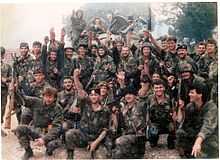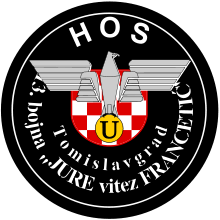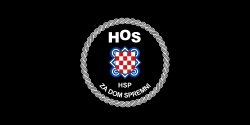Croatian Defence Forces
| Croatian Defence Forces Hrvatske obrambene snage | |
|---|---|
|
Flag of the Croatian Defence Forces | |
| Active | 22 January 1991 – 16 April 1993 |
| Country |
Croatia Bosnia and Herzegovina |
| Allegiance |
|
| Branch | Army |
| Size | 24,000[1] |
| Headquarters |
Zagreb, Croatia Ljubuški, Bosnia and Herzegovina Zenica, Bosnia and Herzegovina |
| Nickname | Blacks (Crnci) |
| Motto | Za dom spremni |
| Colors | Black |
| March | HOS – Za dom spremni |
| Engagements |
Battle of the Barracks Battle of Vukovar Siege of Dubrovnik Siege of Sarajevo |
| Disbanded |
September 1991 in Croatia[2] 21 August 1992 in Bosnia and Herzegovina[3] |
| Commanders | |
| Notable commanders |
Dobroslav Paraga Blaž Kraljević |
The Croatian Defence Forces (Croatian: Hrvatske obrambene snage, HOS) were the military arm of the Croatian Party of Rights (HSP) from 1991 to 1992, during the first stages of the Yugoslav wars. During the Croatian War of Independence, the HOS organized several early companies and participated in Croatia's defense. At the peak of the war in Croatia, the HOS was several battalions in size. The first HOS units were headed by Ante Paradžik, an HSP member who was killed by Croatian police in September 1991. After the November 1991 general mobilization in Croatia and the January 1992 cease-fire, the HOS was absorbed by the Croatian Army.
The HOS units in Bosnia and Herzegovina consisted of Croats, Bosniaks and foreign volunteers led by Blaž Kraljević.[4] On 9 August 1992, Kraljević and eight staff members were assassinated by Croatian Defence Council (HVO) soldiers under the command of Mladen Naletilić.[5] The HOS was disbanded shortly afterwards, and absorbed by the HVO and the Army of the Republic of Bosnia and Herzegovina at the beginning of the Croat-Bosniak War.[4] The last HOS unit was dissolved on 5 April 1993 in central Bosnia.[6]
Name
The frequently used Croatian abbreviation of the organization, "HOS" (Hrvatske obrambene snage), is identical to the abbreviation for the military of the World War II Nazi puppet state, the Independent State of Croatia. The military of the Independent State of Croatia were the Croatian Armed Forces (Hrvatske oružane snage), also abbreviated "HOS" in Croatian.
History
Croatia
Origin
The Croatian Party of Rights was reestablished in Croatia on 26 February 1990, with Dobroslav Paraga president and Ante Paradžik vice-president. The Croatian civilian population began arming itself, and on 21 December 1990 the Serbs of Croatia rose up; soon, the Yugoslav People's Army combined with the insurgent Serbs and the Croatian Party of Rights considered forming its own military wing.
Although the first HOS squad was established in January, the HOS was officially founded on 25 June 1991 by Dobroslav Paraga, Ante Paradžik, Alija Šiljak and other leaders of the HSP. Soon after the establishment of the HOS general staff, Paradžik became its chief. The general staff was at Starčević Center, the HSP headquarters in Zagreb. At first, the HOS was poorly armed and its soldiers used their own weapons. However, they performed well in conflicts with Serb forces and attracted the attention of Croatian public. The HSP received donations from the Croatian diaspora and HSP branches in Australia and Canada, enabling them to buy weapons and increase their membership. Not every HSP member supported a military wing, and secretary Krešimir Pavelić left the party in protest.
Many HOS recruits came from the diaspora: Bosnia and Herzegovina and overseas. In addition, HOS attracted trained soldiers from abroad.
Battles
At the beginning of the Croatian War of Independence, the HOS consisted of about 6,000 soldiers. Although they were members of the Croatian National Guard (ZNG), they obeyed orders from HOS officers. Because of an unwritten rule that HOS members could only be members of the HSP, the HOS was considered a party paramilitary organization. The HOS and the ZNG were involved in the Battle of the Barracks and other minor battles in Croatia. The HOS increased in popularity within the HSP, and soon the HOS were in nearly every town where the HSP was active. On 10 September 1991, Paraga and Paradžik organized a demonstration of an HOS company for 10,000 spectators in Jelačić Square. Shortly after the demonstration, the company was involved in the Battle of Vukovar under Robert Šilić.
At this time, HOS units were founded in Dalmatia. Until May 1991, Dalmatian HOS units were company-sized. In an agreement between Paraga and the Slovene Minister of Defense Janez Janša, the units were sent to Slovenia for training. By October 1991 the unit had grown to battalion size; it was called the 9th Battalion (the Rafael "Knight" Boban Battalion) and was commanded by Jozo Radanović, president of the HSP branch in Split. This unit became one of the most popular Croatian units; in early December 1991, Radanović was promoted to colonel in the HOS.
Paradžik was shot at a police checkpoint near Zagreb on 21 September 1991, in what was described by the authorities as an accident. On 23 November the Croatian government began a general mobilization, and most HOS militiamen joined Croatian Army units. Shortly after the cease-fire in January 1992, the HOS ceased operations in Croatia.
Bosnia and Herzegovina

Blaž Kraljević was a Croat paramilitary leader who commanded the HOS during the first few months of the Bosnian War. When the war began, Kraljević positioned the HOS as the primary Croat militia in Bosnia and Herzegovina. Unlike the HVO, the other Croat militia, the HOS opposed the partition of Bosnia and Herzegovina and an ethnically-cleansed Greater Croatia; instead, they wanted to ally Bosnia and Herzegovina with Croatia.[7]
After early successes, many HVO soldiers defected and joined the HOS.[8] During summer 1992 the HOS defended Stolac, launching an offensive into eastern Herzegovina which seized parts of Trebinje. Much of the Serb population of Trebinje and Bileća had begun to evacuate; this ran counter to the Graz agreement between Republika Srpska and Herzeg-Bosnia concerning the country's division. After Kraljević's death, the HOS in Bosnia and Herzegovina was led by Ante Prkačin and Stanko Primorac.
Symbols
The HOS had a black flag with its emblem in the centre: a circle of triple wattle containing a chequered shield (with white first square) over a four-sided blue-and-white triple-wattle symbol; above, the inscription "HOS"; below, "HSP, Za dom spremni".[9] These symbols resembled those of the NDH, a Croatian state during the Second World War which collaborated with German and Italian occupation forces. "Za dom spremni!" ("Ready for the homeland!") was the official greeting of the NDH army.
Uniforms
The HOS primarily wore black uniforms with World War II NDH-type insignia. They also wore available camouflage uniforms, usually US battle dress or the Croatian equivalent.
Units
| Name | Symbol | Headquarters | Commander |
|---|---|---|---|
| 1st Battalion Ivan "The Knight" Brdar (1. bojna Ivan Vitez Brdar) |
 |
Livno, Bosnia and Herzegovina | Mate Šukan |
| 2nd Battalion Stojan Vujnović "The Serb" (2. bojna Stojan Vujnović Srbin) |
 |
Domaljevac, Bosnia and Herzegovina | Stojan Vujnović |
| 4th HOS Battalion (4. bojna HOS-a) |
|||
| 6th Battalion Marijan Baotić (6. bojna Marijan Baotić) |
Vinkovci, Croatia | ||
| 9th Battalion Rafael "The Knight" Boban (9. bojna Rafael vitez Boban) |
 |
Split, Croatia | Marko Skejo |
| 1st Company Ante Paradžik (1. satnija Ante Paradžik) |
Jasenovac, Croatia | ||
| Vukovar HOS Company (Vukovarska satnija HOS-a) |
Vukovar, Croatia | Robert Šilić | |
| 13th Battalion Jure "The Knight" Francetić (13. bojna Jure vitez Francetić) |
 |
Tomislavgrad, Bosnia and Herzegovina | Ivan Mamić |
| The Knights (Vitezovi) |
 |
Vitez, Bosnia and Herzegovina | |
| 101st Battalion To Drina (101. bojna Do Drine) |
Sarajevo, Bosnia and Herzegovina | ||
| 19th Battalion "The Knight" Jure Francetić (19. bojna Vitez Jure Francetić) |
Gospić, Croatia | Valentin Rajković | |
| Black Wolves (Crni vukovi) |
Kalesija, Bosnia and Herzegovina | ||
| Marked Ones (Žigosani) |
 |
Novi Travnik, Bosnia and Herzegovina | |
| Hunter Company (Satnija Lovci) |
 |
Ljubuški, Bosnia and Herzegovina | |
| Independent Security Company (Samostalna satnija osiguranja) |
Zagreb, Croatia | ||
| Mostar HOS Battalion (Mostarska bojna HOS-a) |
Mostar, Bosnia and Herzegovina | ||
| Ljubuški HOS Company (Ljubuška satnija HOS-a) |
Ljubuški, Bosnia and Herzegovina | ||
| Zenica HOS Company (Zenička satnija HOS-a) |
Zenica, Bosnia and Herzegovina | ||
| Tuzla HOS Company (Tuzlanska satnija HOS-a) |
Tuzla, Bosnia and Herzegovina | ||
| Čapljina HOS Company (Čapljinska satnija HOS-a) |
Čapljina, Bosnia and Herzegovina |
Gallery
-

Standard HOS patch
-

Croatian coat of arms used by HOS soldiers
-

HOS soldiers after the war
-

Jozo Radanović, founder and first commander of the HOS 9th battalion
-

Patch of HOS 9th battalion, 114th brigade
-

Croatian flag used by HOS soldiers
-

Patch of HOS 9th battalion, 4th brigade
-

Rare HOS patch from Herzegovina
-

HOS soldiers after the war
-

HOS-a patch from Prozor-Rama
-

HOS patch for Muslims
-

Patch used by some HOS soldiers in Bosnia and Herzegovina
See also
References
- ↑ "Politička ubojstva: Nedavno uhićenje Ivana Andabaka u žižu vraća ubojstvo Blaža Kraljevića, generala HOS-a, borca za BiH do Drine. I organizatori I ubojice na slobodi". Jutarnje novine (in Bosnian). 1 December 2000. Retrieved 25 April 2011.
- ↑ Absorbed into the Croatian ground army
- ↑ Absorbed into the Croatian Defence Council and Army of the Republic of Bosnia and Herzegovina
- ↑ 4.0 4.1 Nigel Thomas, Nigel Thomas (2006). The Yugoslav Wars: Bosnia, Kosovo and Macedonia 1992–2001. Osprey Publishing. p. 21. ISBN 1-84176-964-9.
- ↑ Ramet, Sabrina P. (2006). The Three Yugoslavias: State-Building and Legitimation, 1918–2004. Indiana University Press. p. 343. ISBN 0-271-01629-9.
- ↑ Shrader, Charles R. (2003). The Muslim-Croat Civil War in Central Bosnia: A Military History, 1992–1994. Texas A&M University Press. p. 46. ISBN 1-58544-261-5.
- ↑ "IT-98-34-T, the Prosecutor versus Naletilic and Martinovic". ICTY. 17 July 2002. Retrieved 25 September 2007.
Q. Well, sir, during the time that you lived in Mostar, during these years, and in that region, did you ever – did you understand that HOS was a unit that – an organization that believed more in a multi-ethnic Bosnia of the Croats and Muslims working together? ... wasn't it because of the HDZ's conflict with that philosophy, that Mr. Kraljevic was ultimately murdered?
- ↑ Pg 85 – "Hewitt, Dawn M. From Ottawa to Sarajevo: Canadian Peacekeepers in the Balkans" (PDF). Centre for International Relations, Queen's University Kingston, Ontario Canada. 1998. Retrieved 25 September 2007.ISBN 0889117888
- ↑ "HOS, Croatian Defence Forces". crwflags. 2008. Retrieved 11 March 2008.
The HOS used a black flag with the emblem in the middle, with a circle of triple-wattle within which is a chequy shield over a four-sided blue-white triple wattle (similar to the one used as Ustasha symbol, on flags of the Independent State of Croatia in World War II), above the inscription HOS, below HSP, ZA DOM SPREMNI (For Homeland. Ready!).
| Wikimedia Commons has media related to Croatian Defence Forces. |
